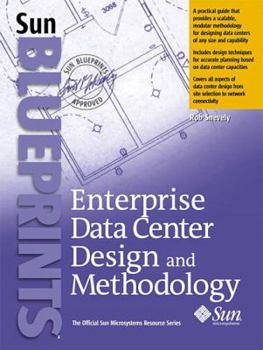Enterprise Data Center Design and Methodology
Enterprise Data Center Design and Methodology is the practical, start-to-finish guide to data center design and retrofitting. It introduces a scalable, modular methodology for designing data centers... This description may be from another edition of this product.
Format:Paperback
Language:English
ISBN:0130473936
ISBN13:9780130473936
Release Date:January 2002
Publisher:Prentice Hall
Length:224 Pages
Weight:0.85 lbs.
Dimensions:0.7" x 7.0" x 9.2"
Customer Reviews
5 ratings
valuable resource
Published by Thriftbooks.com User , 15 years ago
I found this book to be a valuable resource when designing our new datacenter during an office move in 2007. I found the contents useful and easy to read. My only complaint was the overall appearance of the book and diagrams. Given the relatively high cost of this book, I would have preferred to have seen a little more production effort.
Worth Every Penny!
Published by Thriftbooks.com User , 16 years ago
It would be hard to find a more valuable book than this one if you have to design (or participate in the design of) a data center. Rob Snevely covers every possible topic, in an organized, interesting, readable manner. He has clearly done his homework.
Great info, bad pictures
Published by Thriftbooks.com User , 18 years ago
This book seems to be really informative so far. We're in the midst of designing a 700 square foot data center and there are a lot of great tips and tricks we never would have thought of in there. My only complaint so far is the quality of the pictures. They're all black and white, which is fine, but they look like they've been photocopied about 20 times before they made it to the book. Very poor quality there for the price.
Excellent Source for Data Center Design Considerations
Published by Thriftbooks.com User , 18 years ago
I am working on relocating a Data Center to a new building as part of a manufacturing environment. This book provided some valuable background information for selling why I needed things that aren't available in normal office environments. I was dealing with maintenance staff that has no experience with Data Centers and every penny I needed to spend on the increased power, HVAC and security requirements for the facility were a hard sell. This book helped me communicate those needs in a way they understood.
Hard to find information that is clearly presented
Published by Thriftbooks.com User , 22 years ago
There is a large gap between IT data center operations and facilities management professionals. This book bridges that gap, at least on the IT side, by clearly explaining the issues and factors that need to be addressed for effective management of a data center that complies with local codes and regulations. Most IT professionals are unaware of the regulatory requirements with which a data center must comply - unless they've been shut down by a city inspector at which point the concept of reliability, availability and support becomes moot. This book provides a good education about this obscure topic, as well as everything else that a data center operations manager should know in order to do his or her job. This doesn't shift responsibilities away from facilities managers, but does give IT and facilities common ground and a shared understanding of each domains roles and responsibilities. Here's an example of why this is necessary: systems that need to be brought into production usually require platforms, storage and network connections. These consume power, environmental system capacity and require space, all of which are finite and all of which are governed by building, fire and safety codes. Many organizations order equipment first, then notify facilities, when the right way is to jointly plan and manage data center growth. This book provides the basis for doing this, and if followed by both IT and facilities, will ensure smooth and uninterrupted operations and proactive physical capacity management. The book starts with data center design philosophy, giving the top ten design guidelines. This is followed with detailed design criteria that covers project issues, insurance and local building codes. While these are of more concern to facilities managers IT needs to be aware of their impact. It also discusses availability profiles, which does directly concern IT. Chapter 3 is also of direct interest to IT because it discusses physical and logical Security, facilities system monitoring and planning for expansion. In fact, this chapter is where IT and facilities professionals intersect.Chapters 4 through 8 are of more interest to facilities professionals because the topics cover details such as physical capacities and resources, site selection and construction details, implementing raised floors, power distribution and HVAC. Despite the slant towards facilities, reading through these chapters will give IT data center managers insights into the challenges faced by facilities, and will offer a lot of information that can be used to develop safety plans and general housekeeping procedures. The next chapters (9 through 12) are of interest to both IT and facilities, and cover network cabling infrastructure, shipping, receiving, and staging, hazards and environmental contaminants, codes and construction. These are areas in which IT and facilities need to closely collaborate.This is the first book that covers data center facilities in a manner





